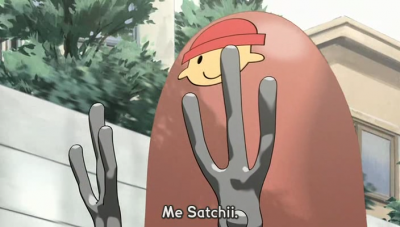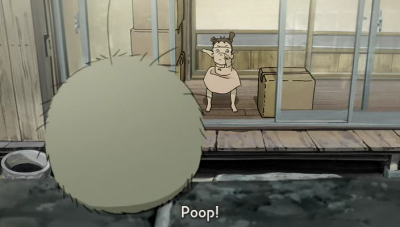Season 4. Unbelievable. I have never seen anything like this in animation before. The battle fetween light and dark, black and white, taken to a literal level instead of merely symbolic.
Author: fledgling otaku
-
Jack and Ikra
From season 1. A short clip but captures so much of what made the series so great, stylistically speaking. The music was just superb in this segment. Title of the episode was, “Jack and the Warrior Woman.”
-
Dennou Coil 2
Some screenshots from episode 2.
Sort of a cute and fuzzy Maximillian. well, shiny, not fuzzy. I love that smiley face.
Reki! already my favorite character.
Tribbles! Man this is the best series ever.
There are exactly two anime I’ve seen where children aged 3-4 were portrayed with any accuracy. Totoro was one, and this is another. Poop.
I use tis face all the time. And I got my fair share of it as a kid.
I am having a blast. It’s like watching Shingu.
-
Dennou Coil OP
I’m watching the Ureshi sub, which provides translit/translate of the song. I am transcribing both below by hand:
daremo ga sagashiteru
dareka wo sagashiteru
te wo nobaseba itsudemo
aru hazu no nukumori wa
osonai hi no maboroshi
mabushisugite mitsumeru koto mo
dekinai taiyo
hikari ga afureru kono michi ni
itsumo kage wa hitotsu
asu wa soko ni aru no daroeveryone is looking for…
…looking for someone
whenever you stretch your hands
the warmth that should be there
is an illusion of your childhood
a sun that’s shining so brightly
to be looked upon
on this street, where the light is overflowing
there’s always one shadow…
The future is probably there. -
Dennou Coil 1
I got a little bored with Sayonara Zetsubu Sensei, so I watched the first episode of Denmo Coil, and was wowed. I love it. It’s like a wierd mix of Totoro, Serial Experiments Lain, and Haibane Renmei. What a fun show! The OP was also particularly good. I can see this one holding my interest.
And I need to get me one of these phones when they come out:
-
to 1080p or not to 1080p
 The prices on HD-DVD players have started to move downwards at Amazon, with the HD-A3 model now priced at $99 and the HD-A30 at $129. The mail-in rebate for 5 free HD-DVDs expires on the 28th, so I assume that there will be further price reductions on the 29th, assuming they have the inventory. Both players come bundled with 300 and Bourne Identity, and I view the BBC Earth series as mandatory.
The prices on HD-DVD players have started to move downwards at Amazon, with the HD-A3 model now priced at $99 and the HD-A30 at $129. The mail-in rebate for 5 free HD-DVDs expires on the 28th, so I assume that there will be further price reductions on the 29th, assuming they have the inventory. Both players come bundled with 300 and Bourne Identity, and I view the BBC Earth series as mandatory. The question is, whether the extra $30 for the A30 is worth it. The primary difference is that the A30 supports 1080p output, whereas the A3 only does 720p/1080i. My intended use for this player is primarily as an upscaler for my standard DVD collection (and NetFlix), for an HDTV I have yet to buy (normal upscaling DVD players cost around $50-$70 anyway). Standard DVDs are 480p. As long as the HDTV unit supports 720p as a native resolution (which it should, regardless of whether I buy a HDTV capable of 1080p or just 1080i), then the 720p output of the A3 is all I will ever need, right? Even if I want to watch my HD-DVD discs at 1080i, few though they presumably will be, will I even be able to tell the difference between it and 1080p?
I can see myself in a similar quandary later when I decide whether to buy a HDTV at 1080p or not. I could just settle for 1080i as my maximum across the board and simplify things. I’d appreciate any suggestions or information regarding the matter, if you all have any.
Highly relevant reading: a piece at the NYT in which they talk to the founder of the Abt Electronics chain. In a nutshell, Blu-ray just isn’t a value proposition right now.
“Most people are happy just buying a better DVD player, instead of spending $350 or $400 for Blu-ray,†Mr. Abt said. “An upconverting DVD for $79 is a great value. It has a great picture, really better than an old DVD. You really see a difference.â€
[…]
What about all the people who bought HD DVD players, prompted by Toshiba’s aggressive price cuts? Mr. Abt hopes he can at least partially mitigate their anger and frustration by pointing out how well the players can display standard DVDs.“We have a lot of people who bought HD DVD players in the last few months,†he said. “We are going to communicate with them: you have an upconverting DVD player, enjoy it. You paid $150 for it, so you didn’t lose too much.â€
And of course, we have less than a year to go before the digital switchover.
UPDATE: HD-DVD players in retailer inventory are now being described as “upscaling DVD players with HD-DVD playback“.
-
beauty and the geek
two websites, one devoted to geek technology enterpreneurs and the other full of fashion and lifestyle. Oil and water, but mix they shall:
PopSugar is a blog all about fashion, beauty, shopping and celebrity news. TechCrunch is about startups and the geeks that create them. These two groups definitely need to mingle.
So on April 10, in Hollywood of course, we are putting on a huge party with them. The theme – Geek Goes Chic. Expect lots of startup geeks commingling with, well, normal people. Who are most likely attractive. And can carry on a conversation. What could could possibly go wrong?
I wish I lived in Hollywood.







